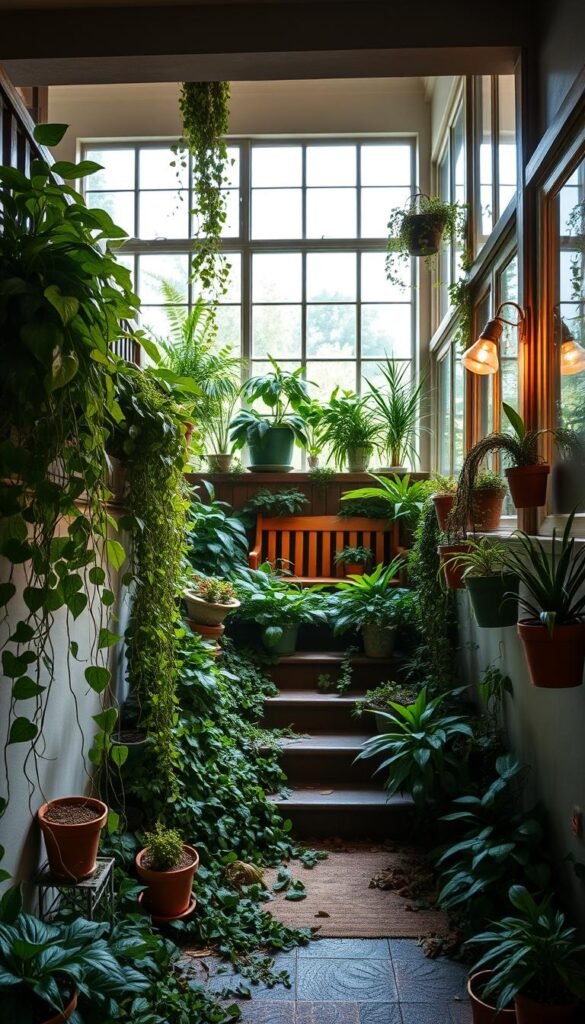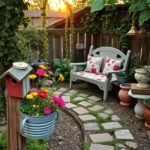Have you ever glanced at that awkward nook beneath your staircase and wondered how to make it useful? This often-overlooked spot holds incredible potential to become your home’s most charming feature. With smart design choices, even tight areas can blossom into vibrant displays of nature that refresh your living environment.
Creating a green oasis in unused zones does more than just beautify your space. Studies show indoor plants purify air and reduce stress, turning once-empty corners into wellness boosters. The key lies in understanding your specific conditions – from sunlight patterns to airflow – before selecting plants that thrive in your unique setup.
We’ll walk through practical steps to assess your staircase area’s possibilities. Learn how to work around structural elements like support beams while choosing plants that match your lifestyle. Whether you’re a busy professional or a plant enthusiast, there’s a solution that keeps your greenery thriving with minimal effort.
By the end of this guide, you’ll see those “problem spaces” through new eyes. That dim corner could become a cascading vertical garden, while that cramped floor area might transform into a cozy reading nook surrounded by ferns. Let’s unlock the hidden value in every square foot of your house!
Embrace Unused Spaces to Invite Nature Indoors
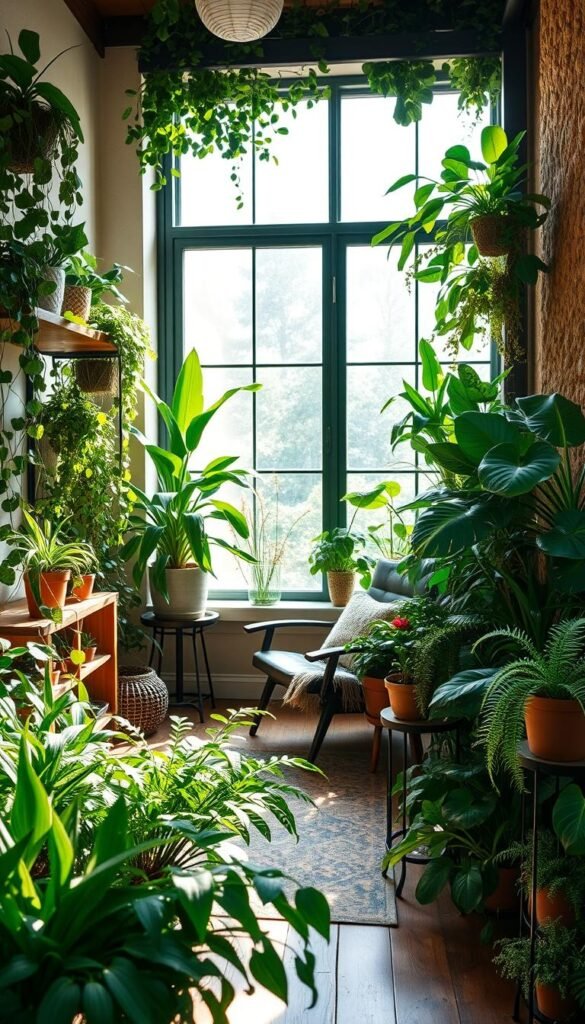
Unused spaces aren’t just wasted square footage—they’re opportunities for growth. That blank wall by your entryway or the awkward gap next to your bookshelf could become your next favorite green zone. With smart planning, these spots evolve into living art that boosts air quality and mood.
Understanding the potential of overlooked corners
Start by identifying areas collecting dust instead of life. Measure floor space and wall height in your chosen spot. Check for nearby outlets if you’ll need grow lights. Note airflow patterns and temperature changes throughout the day.
Architectural features like sloped ceilings or beams can inspire creative layouts. A narrow corner might host tall snake plants, while a wider area could accommodate a compact potting station. Always leave room for watering cans and pruning tools.
Tips for starting your indoor garden transformation
Clear clutter first—old boxes or unused items block energy flow. Wipe surfaces thoroughly to remove dust. Use waterproof trays under planters to protect floors. Address moisture issues with dehumidifiers if needed.
Choose plants matching your light conditions. Low-light varieties like pothos thrive in dimmer spaces. Bright areas allow for flowering species. Group plants with similar care needs to simplify maintenance.
Your once-empty room zones now become thriving ecosystems. These ideas help you work with existing layouts instead of costly renovations. Soon, you’ll walk past these transformed areas and smile at nature’s touch.
Garden Under Stairs Indoor: Turning Neglected Corners into Plant Havens
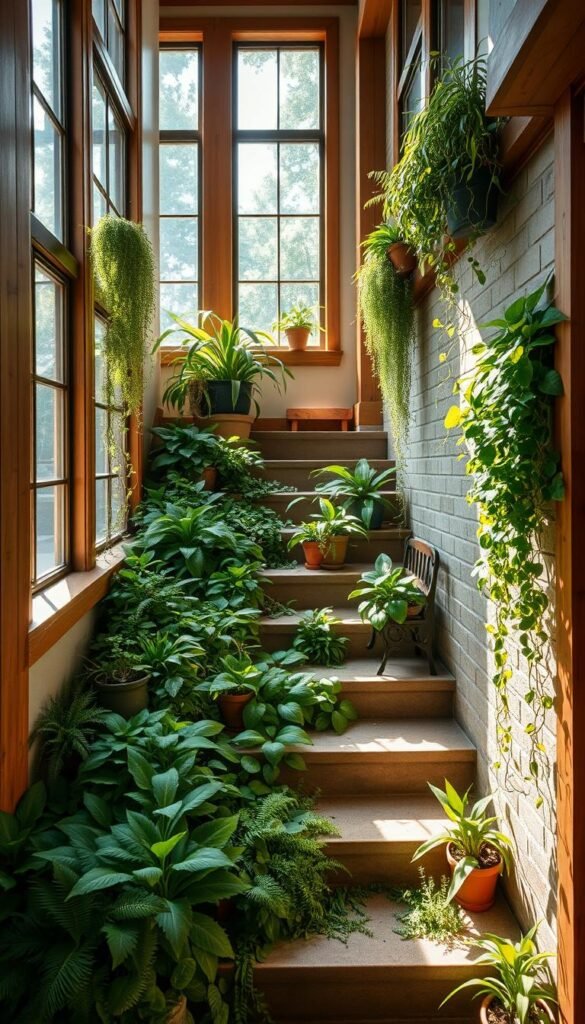
That shadowy spot beneath your steps holds more potential than you think. With smart layout choices, it becomes a vibrant living display that breathes life into forgotten areas. Start by choosing foliage that thrives in indirect light—pothos and peace lilies adapt beautifully while cleaning your air.
Build upward with floating shelves or staggered plant stands. This approach creates depth while letting each specimen catch available light. Pair trailing varieties with upright plants for dynamic contrast—think spider plants cascading beside compact snake plants.
- Install energy-efficient LED strips under shelves for growth-friendly illumination
- Use self-watering pots to simplify maintenance in hard-to-reach spots
- Rotate plants monthly to ensure even light exposure
Choose containers that match your decor—glossy ceramics for modern spaces, woven baskets for rustic charm. Ensure proper drainage to protect surfaces, and group plants by moisture needs. For more small-space gardening hacks, explore our vertical planting guides.
Complete the look with warm accent lighting. Soft-glow string lights highlight leaf textures without overwhelming the space. Your transformed corner becomes a peaceful escape where greenery softens angular architecture—proof that even tight spaces can flourish.
Vertical Garden Innovations for Small Spaces
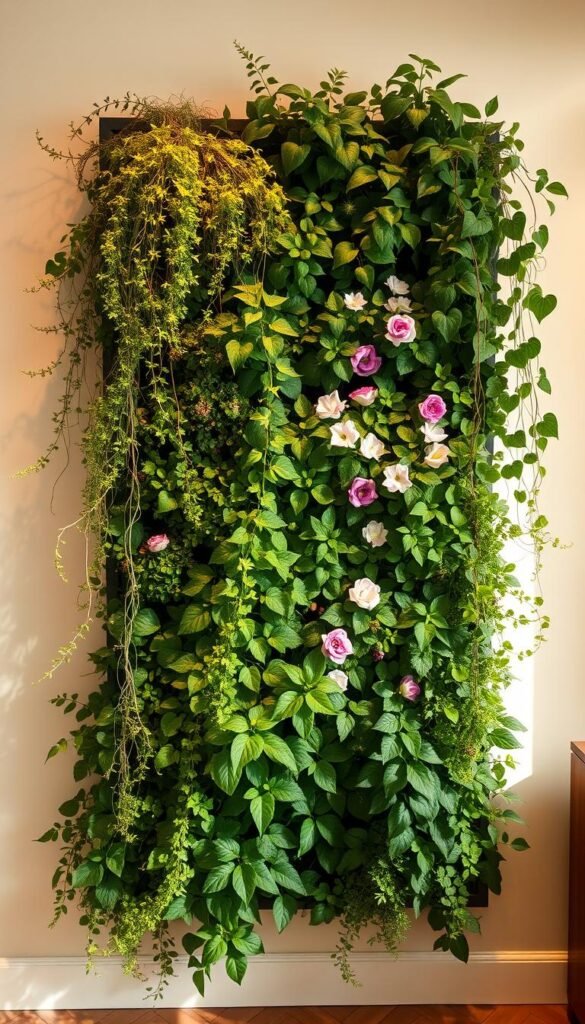
Transform blank walls into living art with vertical garden solutions that maximize every inch. These space-saving designs turn plain surfaces into thriving ecosystems while keeping floors clear. Let’s explore two approaches that combine functionality with striking visual appeal.
Hanging plant walls with cascading greenery
Create natural curtains using trailing varieties like English Ivy or Golden Pothos. Mount brackets at different heights to form layered displays. This method adds textural depth while making use of underutilized wall areas.
Consider these popular options for vertical arrangements:
| Plant Type | Growth Rate | Light Needs |
|---|---|---|
| Boston Fern | Moderate | Medium indirect |
| String of Pearls | Slow | Bright indirect |
| Philodendron | Fast | Low to medium |
Utilizing floating shelves for a modern look
Install sleek shelves to showcase your plant collection in style. Alternate between upright succulents and trailing varieties for dynamic contrast. This approach works particularly well in tight corners where floor space is limited.
Follow these tips for shelf success:
- Use moisture-resistant materials like sealed wood or metal
- Leave 12-18″ between shelves for plant growth
- Mix pot sizes for visual interest
Both methods let you redefine your walls as functional decor elements. Whether you choose flowing greenery or structured displays, these vertical solutions prove that upward growth offers endless possibilities.
Multi-Tier Plant Stands to Elevate Your Greenery
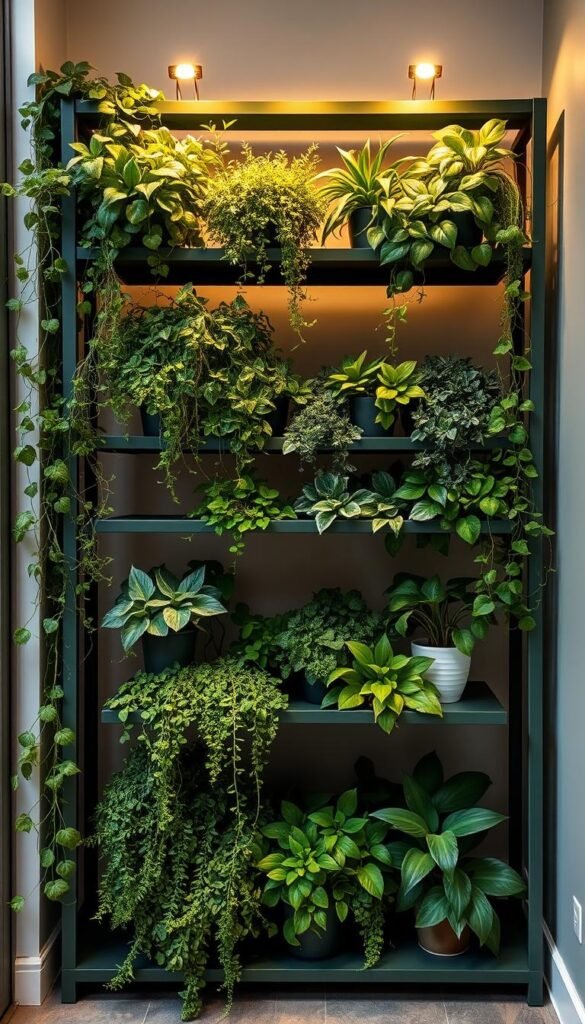
Imagine transforming that bare corner into a lush, layered paradise with just one piece of furniture. Tiered stands turn vertical space into a thriving showcase, letting you grow more without crowding your floors. Three-level designs work best for creating visual depth while keeping care routines simple.
Arranging plants of varying heights
Start with tall specimens like fiddle-leaf figs at the base. Place medium-height ferns or prayer plants on middle shelves. Top tiers shine with trailing pothos or string-of-pearls. This setup ensures each plant gets light while creating a waterfall effect.
Choose materials that blend with your style. Wooden stands add earthy warmth, while powder-coated metal offers modern durability. Both options handle moisture well when sealed properly. Leave 6-8 inches between pots for air flow and future growth.
Group plants by water needs to simplify care. Keep succulents together on sunny tiers, and moisture-loving ferns on shaded levels. Rotate stands weekly so all sides get equal light exposure. Your once-empty nook becomes a living sculpture that evolves daily.
Boho Chic Corners with Macrame and Woven Hangers
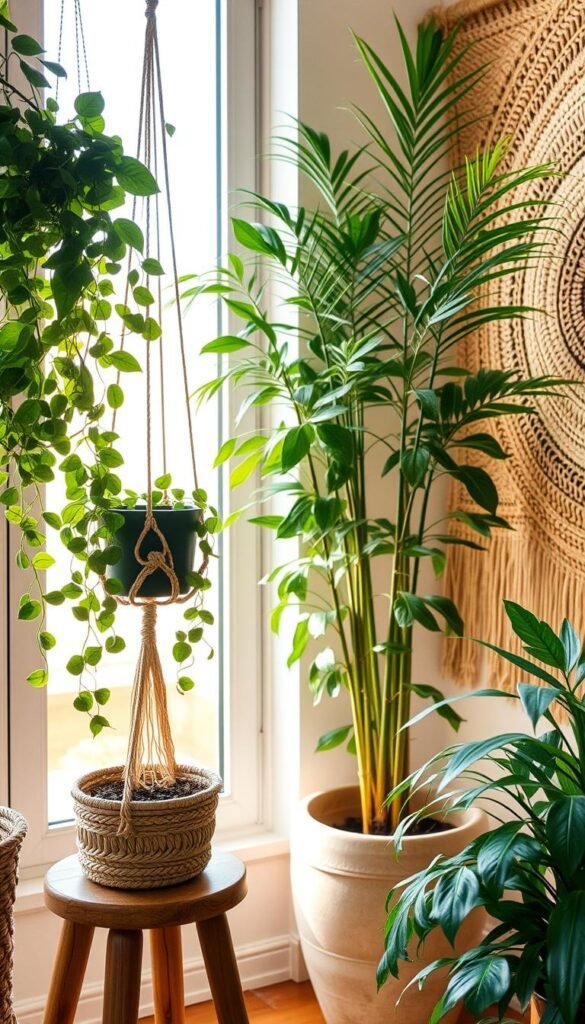
Transform your empty corners into cozy retreats where textiles meet trailing foliage. Macrame hangers add organic texture while showcasing your favorite plants in mid-air elegance. This design approach turns forgotten areas into free-flowing displays that radiate bohemian charm.
Start by choosing 3-5 hanging points at different levels. Stagger spider plants and philodendrons to create natural layers. “Macrame isn’t just functional – it’s wearable art for your walls,” notes interior designer Mara Santos. Mix chunky knotted designs with delicate woven patterns for visual contrast.
| Macrame Style | Best Plants | Decor Pairings |
|---|---|---|
| Geometric knots | String of Hearts | Brass planters |
| Fringed designs | Devil’s Ivy | Jute floor mats |
| Beaded accents | Burro’s Tail | Clay pottery |
Complete your boho sanctuary with these styling secrets:
- Use cotton cords in warm earth tones for natural appeal
- Pair hanging plants with floor-level snake plants in rattan baskets
- Add patterned throw pillows matching your hanger colors
Rotate plants weekly to ensure even growth in your airy setup. The result? A corner that feels like a sunny café nook – perfect for morning coffee surrounded by greenery.
Rustic Ladder Displays: A Blend of Function and Style
That weathered ladder in your garage isn’t just salvage—it’s a blank canvas for botanical creativity. Lean it against a wall to create a vertical oasis that combines practical storage with farmhouse charm. These displays turn forgotten corners into focal points, blending natural textures with living greenery.
Designing with reclaimed materials
Start by selecting a ladder with character—chipped paint, worn edges, or natural wood grain add authenticity. “The beauty lies in imperfections,” says furniture restorer Lila Carson. “Each scratch tells a story while supporting your plant collection.” Secure it at a slight angle using wall anchors for stability without compromising the casual aesthetic.
Pair your ladder with containers that enhance its rustic vibe:
| Planter Type | Best For | Style Match |
|---|---|---|
| Terracotta pots | Succulents | Earth tones |
| Galvanized buckets | Herbs | Industrial farmhouse |
| Woven baskets | Trailing ivy | Bohemian |
Follow these tips for a thriving display:
- Place taller plants on lower rungs to maintain visibility
- Use saucers to protect wood surfaces from water damage
- Rotate pots weekly for even sun exposure
Your ladder becomes more than furniture—it’s a living sculpture that evolves with each season. By mixing textures and plant heights, you’ll craft a dynamic design that breathes life into unused spaces.
Terrarium Display Tables for Artistic Indoor Gardens
Your coffee table could double as a living art piece with smart terrarium integration. These innovative surfaces merge functional furniture with miniature ecosystems, letting you admire lush greenery while sipping morning tea. Glass-topped designs reveal carefully arranged succulents and moss beneath, turning ordinary tablescapes into conversation starters.
Choose models with built-in compartments for easy plant care. Sliding drawers let you adjust decorative stones or swap air plants without disrupting your table’s surface. For modern spaces, opt for clean-lined designs with integrated LED lighting that mimics natural sunlight cycles.
Style your botanical centerpiece with these tips:
- Layer pebbles and driftwood for textural contrast
- Use drought-tolerant species to minimize maintenance
- Pair with transparent chairs to maintain visual flow
This approach transforms overlooked corners into living galleries. Your table becomes both workspace and garden showcase – proof that creative solutions thrive in tight spaces. Whether hosting guests or enjoying quiet moments, you’ll appreciate nature’s beauty at eye level.

